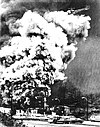- Monongah, West Virginia, 1907 (362 killed)
- Dawson, New Mexico, 1913 (263 killed)
- Cherry, Illinois, 1909 (259 killed)
- Jacobs Creek, Pennsylvania, 1907 (239 killed)
- Fraterville, Tennessee, 1902 (216 killed)
- Scofield, Utah, 1900 (200 killed)
- Mather, Pennsylvania, 1928 (195 killed)
- Eccles, West Virginia, 1914 (180+ killed)
- Cheswick, Pennsylvania, 1904 (179 killed)
- Castle Gate, Utah, 1924 (171 killed)
- Hanna, Wyoming, 1903 (169 killed); 1908 (59 killed)
- Marianna, Pennsylvania, 1908 (154 killed)
- Frontier Mine disaster, Kemmerer, Wyoming, 1923 (138 killed)
- Banner Mine disaster, Littleton, Alabama, 1911 (128 killed)
- Saunders, West Virginia, 1972 (125 killed)
- Dawson, New Mexico, 1923 (123 killed)
- Hastings, Colorado, 1917 (121 killed)
- West Frankfort, Illinois, 1951 (119 killed)
- Benwood, West Virginia, 1924 (119 killed)
- Layland Mine disaster, Layland, West Virginia, 1915 (115 killed)
- Johnstown, Pennsylvania, 1902 (112 killed)
- Hueytown, Alabama, 1905 (112 killed)
- Pocahontas, Virginia, 1884 (112 killed)
- Centralia, Illinois, 1947 (111 killed)
- Plymouth, Pennsylvania, 1869 (110 killed)
- Everettville, West Virginia, 1927 (109 killed)
- Mammoth Mine disaster, Mount Pleasant, Pennsylvania, 1891 (109 killed)
- Krebs Mine disaster, Krebs, Oklahoma, 1892 (100 killed)
| |
